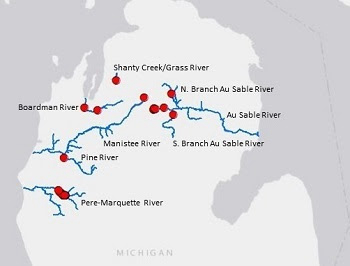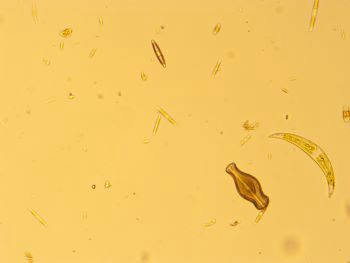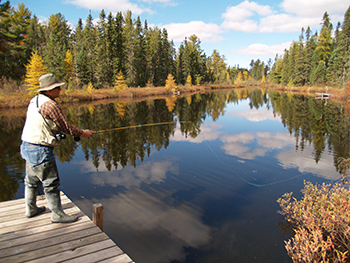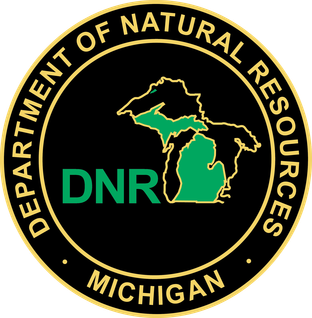Michigan: Invasive New Zealand Mudsnails Found in Shanty Creek

Anglers urged to step up prevention efforts during salmon season
Invasive New Zealand mudsnails have been detected at the mouth of Shanty Creek, a tributary of the Grass River in Antrim County. The snails were found during routine monitoring in May by the Grass River Natural Area Stream Watch project and confirmed through DNA analysis by Oakland University in August.
New Zealand mudsnails were first discovered in the United States in Idaho’s Snake River in 1987. Since then, the snails have spread throughout the western states and into areas of the Great Lakes by attaching themselves to boats, waders and equipment.
The Grass River is now the sixth river system in Michigan known to be infested by the mudsnails. Their discovery in the Pere Marquette River in August 2015 signaled the first detection in a Michigan inland waterway. In 2016, populations were confirmed in the Boardman and Au Sable rivers. By 2017, the invasive snails were found in the Upper Manistee and Pine rivers.
Michigan’s salmon season, which peaks in September and October, draws thousands of anglers to Michigan’s premier rivers.
“This is a time when people are likely to visit multiple rivers and streams over a few days,” said Lucas Nathan, Michigan Department of Natural Resources aquatic invasive species coordinator. “If they are not cleaning equipment thoroughly each time, there is a potential to introduce New Zealand mudsnails into new waters.”
What harm can a snail do?
This brown to black, one-eighth-inch long mudsnail, a native of New Zealand, is considered invasive and is prohibited in Michigan due to the environmental harm it can cause to rivers, streams and lakes. Because the snail reproduces by cloning (females develop complete embryos without fertilization), a single snail can start an entire population.
| One snail can produce over 200 young in a year. Since few natural predators or parasites of this species exist in North America, their numbers grow rapidly each year. In some locations in western states, researchers have documented snails reaching densities of 300,000 per square meter. With that many mudsnails, food for other stream invertebrate populations can become scarce.
Fish that feed on native invertebrates like mayflies and caddisflies may find it more difficult to forage in rivers invaded by New Zealand mudsnails. Fish will consume New Zealand mudsnails, but due to the snail’s thick shell, equipped with a tightly closing “hatch” called the operculum, they are difficult for fish to digest, offer the fish little nutritional value and can be excreted alive. Substituting mudsnails for native food sources can reduce the growth, condition and ultimately the abundance of key sport fish including trout. |
What is being done?
Since the initial detection, the DNR and Department of Environment, Great Lakes, and Energy have incorporated mudsnail monitoring into their standard sampling procedures, increasing the potential for early detection in several rivers and streams each year.
Volunteers across the state, like those with the Grass River Natural Area Stream Watch, conduct regular monitoring of streams and rivers through the Michigan Clean Water Corps, or MiCorps, to determine stream health and look for invasive species. Other partners, including universities and cooperative invasive species management areas also engage in annual monitoring.
| Emily Burke, conservation and education specialist with Grass River Natural Area, Inc., said she was able to identify New Zealand mudsnails while sampling Shanty Creek thanks to invasive species identification training provided by the CAKE (Charlevoix, Antrim, Kalkaska and Emmett) CISMA in the spring.
“The Michigan Invasive Species Grant Program has been instrumental in fostering the development of CISMAs across the state, creating a network of local invasive species resources,” Nathan said. “At the same time, the grant program supports research efforts like Oakland University’s New Zealand mudsnail project, which has raised awareness among anglers, trained citizen scientists and developed an important partnership with Trout Unlimited, which helped to initiate the New Zealand Mudsnail Collaborative.” Following Burke’s report, a team from Oakland University conducted monitoring on 15 sites in the Grass and Elk rivers but found no additional infestations. Local and state partners will continue to monitor the area and use outreach opportunities like Aquatic Invasive Species Awareness Week to educate the public about preventing the spread of New Zealand mudsnails and other harmful species. |
What can you do?
The most important means of prevention is practicing good recreational hygiene. After a visit to one of Michigan’s lakes, rivers or streams, be sure to clean, drain and dry your boat, trailer and equipment before heading to a new destination.
The New Zealand mudsnail’s small size requires careful examination and cleaning of places where plants, mud or debris can be found on poles, nets, waders, boots, buckets, kayaks, canoes and flotation devices. Anything that has been in the water or at the water’s edge should be inspected before it is packed or loaded.
The NZMS Collaborative offers these simple steps for cleaning boots and waders:
- Stomp and inspect as soon as you leave the water to remove attached debris.
- Brush waders, soles and laces to loosen remaining debris and mud.
- Spray boots and waders thoroughly with a disinfecting agent.
- Rinse after 20 minutes.
- Dry waders thoroughly before next use.
The short video, New Zealand Mudsnail Ecology and Fishing Gear Decontamination in Michigan, available at NZMSCollaborative.org, provides a demonstration of this cleaning technique as well as information on how to identify the invasive snail.
Additional information on New Zealand mudsnail, including how to report a suspected discovery of the snail, can be found at Michigan.gov/Invasives.
Michigan’s Invasive Species Program is cooperatively implemented by the Department of Environment, Great Lakes, and Energy, the Department of Natural Resources, and the Department of Agriculture and Rural Development.






